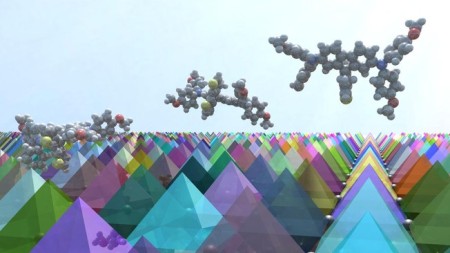Jan
27
A Big Cost Cut For Perovskite Solar Cells
January 27, 2016 | Leave a Comment
Ecole Polytechnique Fédérale de Lausanne (EPFL) scientists have developed a solar-panel material that can cut down on perovskite based photovoltaic costs. Meanwhile the new cells achieve a competitive power conversion efficiency of 20.2%.
Today, some of the most promising solar cells today use light-harvesting films made from perovskites – a group of materials that share a characteristic molecular structure. However, perovskite-based solar cells use expensive “hole-transporting” materials, whose function is to move the positive charges that are generated when light hits the perovskite film.
Publishing in Nature Energy, the EPFL scientists report engineering a considerably cheaper hole-transporting material that costs only a fifth of the existing ones while keeping the efficiency of the solar cell above 20%.

Graphical image of FDT Molecules On A Surface of Perovskite Crystals. Image Credit: Sven M. Hein. Click image for the largest view.
As the quality of perovskite films increases, researchers are seeking other ways of improving the overall performance of solar cells. Naturally, this search targets the other key elements of a solar panel, the hole-transporting layer, and specifically, the materials that make them up. There are currently only two hole-transporting materials available for perovskite-based solar cells. Both types are quite costly to synthesize, adding to the overall expense of the solar cell.
To address the problem, a team of researchers led by Mohammad Nazeeruddin at EPFL developed a molecularly engineered hole-transporting material, called FDT, that can bring costs down while keeping efficiency up to competitive levels. Tests showed that the efficiency of FDT rose to 20.2% – higher than the other two, more expensive alternatives. And because FDT can be easily modified, it acts as a blueprint for an entire generation of new low-cost hole-transporting materials.
Nazeeruddin explained, “The best performing perovskite solar cells use hole transporting materials, which are difficult to make and purify, and are prohibitively expensive, costing over €300 per gram preventing market penetration. By comparison, FDT is easy to synthesize and purify, and its cost is estimated to be a fifth of that for existing materials – while matching, and even surpassing their performance.”
Perovskite cells are coming. The perovskite parts looks to be quite long lasting. Lets hope the team’s new material is quite long lasting, too, as well as being so much less expensive.

